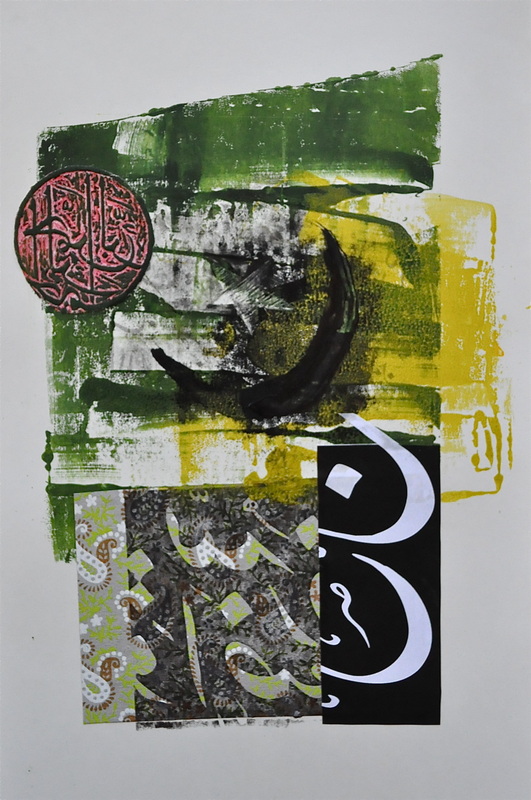Islamic Art from Pakistan to San Francisco
A conversation with Sophia Ahmed Sattar, Pakistani – American artist
Interview with
Sophia Ahmed Sattar
Interview
Sophia Ahmed Sattar, born and raised in a politically unstable Pakistan, decided to take her art career far away from her homeland: to the US.
After living in Louisiana, she moved to San Francisco, where she completed her MFA at the Academy of Art University.
Her art is personal, aesthetic and political, all at the same time. In her paintings and prints we can recognize her background. Going back to her roots, she was heavily influenced by the colorful Pakistani truck art in which color and calligraphy mix.
As time passed by, her art developed as a hybrid, a bridge between her Eastern roots and her Western present. In her words: “Coming from a culture that is blunt and expansive, I was adapting to my new country that was sophisticated and urban. Crossing that bridge was a very intricate departure.” But this is nonetheless the final goal of art and artists: crossing the border and reach out.
The art of a Muslim woman living in the US cannot be anything other than political and meaningful, against the mainstream representation of Islam in contemporary media and popular culture. And this is the key concept of art: not only beauty and aesthetics, but developing counter-narrative and rephrasing history and contemporaneity.

Print 4, print.
By Sophia Ahmed Sattar.

The Crescent Moon,oil on canvas.
IWA: What is Islamic art for you and what do you convey of your multicultural background in your paintings?
Sophia Ahmed Sattar: The concept of Islamic art has changed over the years. It started as mere decoration for the walls of the Kabah and continued to adorn the walls of masjids in the Muslim world. But as the world shrinks and inter-cultural exchange happens, art transforms. As Islam comes into the forefront of world politics, artist are compelled to take their art towards it. For me and many artist living in the US, Islamic art has become a vehicle for transporting views: political, urban, cultural issues. As I live in the US and am raising a family, I face issues of multicultural engagement and that is what I portray in my work.
IWA: You, like many other contemporary Muslim artists, live the US. There you create an art that is inevitably influenced both by your own Pakistani roots and by the environment you live in. Many definitions have been proposed to define ‘Contemporary Islamic Art’. What is contemporary Islamic art for you? How can you define it taking into account the hybridization process it undergoes?
Ms. Sattar: Contemporary Islamic art doesn’t have to have calligraphy in it or minarets or mosques. Artist like Monir Shahroudy and Shazia Sikandar use fundamentals of Islamic art and have expanded on it. Both are heavily influenced by their culture and religion.
IWA: You have been living in the US for 17 years now, and in these years the image of the Islamic World and of Muslims have changed, due to, for instance, 9/11 and in the last few months, ISIS. How has your life as a Muslim and as a Muslim artist changed? Against which old and new stereotypes do you want to fight?
Ms. Sattar: Islam has taken a 180 turn in these past years, from being an exotic, mysterious religion to a terrorist platform. The change was overnight and instantaneous. It really took a long time to absorb what was really going on. A number of racist remarks and unadulterated events filter through my work. The stereotypes did not change after 9/11. First it was the Taliban, now ISIS. They bring the same message and the West feeds off of it. And some artists like me try to fight it by showcasing the beauty and the pure message of Islam.
IWA: Your paintings aim at representing the beauty of Islam, but your art is also highly political. How can you combine the political and the aesthetic dimensions in your works?
Ms. Sattar: Well, I do so by combining my Western art education with my cultural and religious sensibility. I use alphabets as loops rather than words, an ancient tradition in Islamic art. I combine the play of color, composition and design. My work is not flat but has dimension and depth.
IWA: Which of your works do you think best represents you as an artist?
Ms. Sattar: It would be the “Crescent Moon”. I guess because of the title. The crescent moon represents Islam. It is also a well balanced composition and a successful painting allover.
IWA: Would you define yourself as an Islamic artist?
Ms. Sattar: Yes.

Alphabet Twin, oil on canvas.

I am Sophia sattar”s mother (DrTahira Ahmed)& very much proud of my daughter as she represent a true artist As a child very much interested in drawing the human parts from medical journals & other mail. once she went to the Anatomy museum of medical school in Pakistan to draw the parts of human from specimen First i thought sophia is interested in medical sciences But wanted to study Arts & got admission in a prestigious college in Karachi pakistan She graduated got married came to USA &completed post graduation God bless her